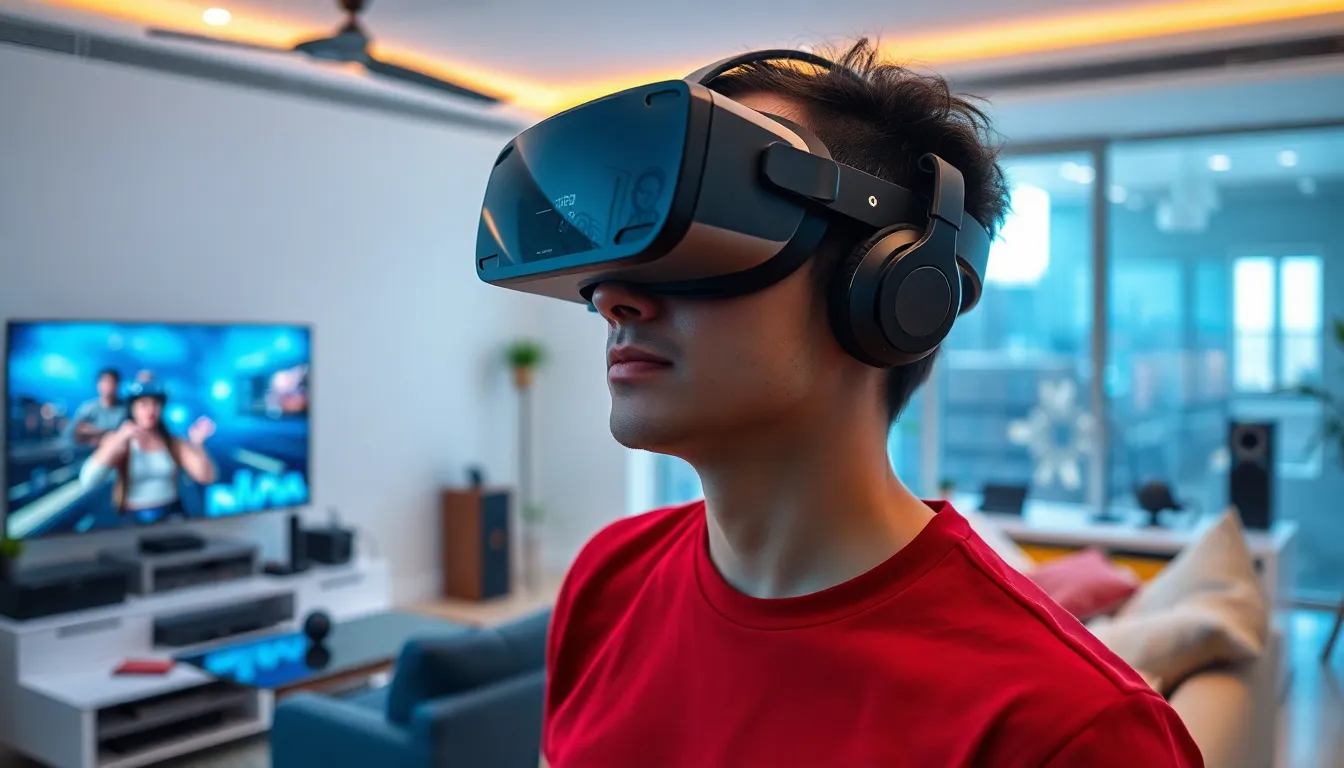In a world where reality sometimes feels a bit too mundane, virtual reality headsets swoop in like a superhero to save the day. Whether he’s battling aliens in outer space or exploring underwater kingdoms, the right VR headset can transport anyone to a whole new dimension. But with so many options out there, finding the best one can feel like searching for a needle in a virtual haystack.
Fear not, adventurers! This guide is here to help navigate the dizzying array of VR headsets on the market. From budget-friendly options that won’t break the bank to high-end devices that make you feel like you’re living in a sci-fi movie, there’s something for everyone. Buckle up as we dive into the best VR headsets that’ll make you question why you ever settled for plain old reality.
Table of Contents
ToggleOverview of VR Headsets
Virtual reality headsets come in various types, offering diverse experiences. Entry-level headsets typically connect to smartphones or PCs, providing accessible options for newcomers. Mid-range devices enhance graphics and performance, catering to gamers and enthusiastic users. High-end models stand out with immersive graphics, advanced tracking technology, and superior audio feedback.
Specifications vary among headsets. Resolution plays a critical role in picture clarity, while refresh rates affect smoothness of motion. Field of view influences the user’s perception of immersion, making wider angles more desirable. Tracking methods also differ; inside-out tracking eliminates external sensors, simplifying setup and use for the user.
User comfort is another essential aspect. Adjustable straps and face padding ensure extended sessions remain enjoyable. Weight distribution affects overall comfort, with lighter models often preferred for long gaming experiences. Wireless options eliminate cumbersome cords, adding to the freedom of movement.
Compatibility matters as well. Many headsets support multiple platforms such as SteamVR and Oculus Store. Ensuring the chosen device works with existing hardware enhances the overall experience. Accessories further enhance capabilities, enabling users to add controllers or external sensors for greater interaction.
Popular brands offer reliable options. Oculus provides a strong line-up suitable for various budgets. HTC Vive is known for its premium features, appealing to hardcore gamers. Sony’s PlayStation VR serves console users, making VR accessible to a broader audience.
Choosing the right headset relies on personal preferences and intended use. Assessing needs in terms of gaming, productivity, or exploration helps narrow down options. Ultimately, understanding these factors leads to a satisfying VR experience tailored to individual desires.
Key Features to Consider

Selecting the right VR headset involves evaluating several key features that directly impact performance and user experience.
Display Quality
Display quality plays a crucial role in immersion. Higher resolution results in sharper images. Popular options range from 1080p to 4K, enhancing clarity and detail in virtual environments. Refresh rates also contribute to visual fluidity. Aiming for at least 90Hz ensures smoother animations, which minimizes motion blur. Additionally, consider the type of display technology. LCD and OLED provide different viewing qualities, with OLED typically offering richer colors and deeper blacks. Evaluating these aspects leads to a more enjoyable experience.
Field of View
Field of view (FOV) affects peripheral vision within virtual reality. A wider FOV, typically between 90 to 110 degrees, enhances immersion by allowing users to perceive their environment more naturally. Narrower fields can feel constricting, while broader ranges create a more expansive sensation. Users seeking a comprehensive VR experience should prioritize headsets with optimized FOV metrics. This aspect becomes particularly relevant in gaming and simulation scenarios where situational awareness is imperative.
Tracking Technology
Tracking technology defines how accurately the headset follows head and body movements. Advanced systems use inside-out tracking, which relies on built-in sensors, while outside-in tracking utilizes external base stations for precision. Inside-out systems are generally more convenient, eliminating the need for additional setup. High-end headsets often incorporate six degrees of freedom, allowing users to move freely and interact authentically with virtual environments. Robust tracking technology enhances the overall experience and supports a wide range of applications, from gaming to educational tools.
Top VR Headsets of 2023
The landscape of virtual reality continues to evolve, with several standout headsets emerging in 2023.
Oculus Quest 2
Oculus Quest 2 remains a popular choice for its affordability and versatility. Users enjoy a resolution of 1832 x 1920 per eye, providing crisp visuals. Its standalone capability eliminates the need for a PC or console. Wireless convenience allows gamers to move freely without being tethered. This headset supports an extensive library of games, enhancing the overall experience. Comfort is well-designed with adjustable straps and lightweight construction.
HTC Vive Pro 2
HTC Vive Pro 2 is known for its exceptional display quality. Featuring a resolution of 2448 x 2448 per eye, it offers stunning visuals. The 120Hz refresh rate ensures smooth motion, ideal for fast-paced gaming. Users appreciate its robust tracking technology, which enhances immersion through precise movement detection. Compatibility with SteamVR allows access to a vast array of content. High-quality audio integrated into the headset enhances the overall experience, making it a premium choice for enthusiasts.
PlayStation VR2
PlayStation VR2 is a great option for PlayStation 5 owners seeking an immersive experience. Offering 2000 x 2040 resolution per eye, it delivers sharp graphics. The advanced haptic feedback feature adds a unique layer of sensory detail. Users can explore a selection of exclusive titles tailored for the platform. Wide 110-degree field of view enables a more expansive virtual sight. Its ergonomic design ensures comfort during lengthy gaming sessions, making it a strong contender in the VR market.
Comparison of Different Models
Oculus Quest 2 stands out for affordability and versatility. It offers a resolution of 1832 x 1920 per eye, allowing users to enjoy vibrant graphics without needing a connected PC. This standalone capability supports wireless gaming, broadening access for casual gamers.
HTC Vive Pro 2 excels in display quality, featuring an impressive resolution of 2448 x 2448 per eye. Users benefit from robust tracking technology, making this headset suitable for serious VR enthusiasts. Such performance enhances immersion, catering to those seeking the highest quality in their virtual experiences.
PlayStation VR2 serves as an excellent choice for PlayStation 5 owners. With a resolution of 2000 x 2040 per eye, this headset includes advanced haptic feedback for a more interactive experience. Its ergonomic design ensures comfort during extended gaming sessions, appealing to users prioritizing long-term use.
Valve Index delivers a high-end gaming experience through its 1440 x 1600 resolution per eye. Known for its superior refresh rates, it offers smooth visuals that enhance gameplay. This model stands out for its high-quality audio, providing an engaging auditory experience alongside the visual elements.
Pimax 8K X shines with its expansive field of view, reaching up to 200 degrees. Such a wide FOV immerses users in virtual environments, making them feel part of the action. With a dual 3840 x 2160 resolution per eye, it appeals to consumers seeking ultimate visual fidelity.
Each model has unique specifications tailored to different needs and preferences. When comparing performance, resolution, tracking capabilities, and comfort, users can make informed decisions that align with their VR aspirations.
Choosing the best VR headset is a personal journey that hinges on individual preferences and intended use. With a variety of options available from budget-friendly to high-end models, users can find a headset that fits their unique needs.
Key features like display quality, tracking technology, and comfort play significant roles in enhancing the VR experience. Whether it’s gaming, productivity, or exploration, the right headset can transform how users interact with virtual worlds.
By considering these factors, anyone can embark on an exciting VR adventure tailored just for them.



